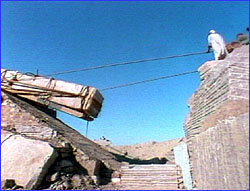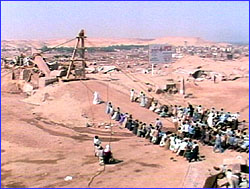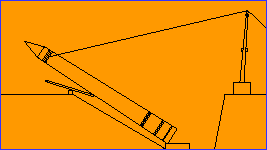
|

|

|
|
 1. Resting on a sled that moved over rollers, the
giant obelisk was pulled to the edge of a steep ramp.
1. Resting on a sled that moved over rollers, the
giant obelisk was pulled to the edge of a steep ramp.
|
First Attempt
by Rob Meyer
In 1995, a NOVA team dared to demonstrate firsthand what has
mystified historians for millennia: how to raise an obelisk
using only materials and techniques the ancient Egyptians
might have used. Archaeologist
Mark Lehner
relied on scholarship to investigate these materials and
techniques.
Roger Hopkins,
an expert stonemason, pushed the group forward with an
unyielding optimism and a keen knowledge of the granite that
they were to work with. The late Aly el Gasab, one of Egypt's
foremost specialists in moving heavy statues, brought his vast
experience to the project and motivated the hundreds of
Egyptian workers who struggled to accomplish this monumental
task. Finally, Martin Isler, a sculptor and graphic artist
with a passion for stonework, provided his own theories and
tried to keep the team's ideas realistic.
 2. Once the obelisk began to pivot over the edge,
three braking ropes attached to the monument's tip
were pulled taut to control the fall. Were the ropes
to fail, the granite obelisk would violently smash
against the ground and crack.
2. Once the obelisk began to pivot over the edge,
three braking ropes attached to the monument's tip
were pulled taut to control the fall. Were the ropes
to fail, the granite obelisk would violently smash
against the ground and crack.
|
|
The first challenge was to secure an obelisk, which the
ancients traditionally sculpted from a single piece of granite
carved from quarries in Aswan. Lehner sought hints about
ancient quarrying at the so-called Unfinished Obelisk, a
monolith that some unidentified pharaoh abandoned after
structurally dangerous cracks appeared during its removal.
Other evidence suggests that ancient laborers pounded away the
surrounding granite with round hammers of dolorite, which is
harder than granite. Foremen likely assigned small "working
patches" to each laborer, who would spend months or possibly
even years chipping away at the hard granite. It was not long
before Roger Hopkins, the stonemason, realized that, if the
team wanted an obelisk anytime soon, it needed a shortcut. The
crew then brought in bulldozers and other modern machinery,
which quickly quarried a large obelisk for the NOVA team.
|
 3. Once in place, the obelisk was removed from its
sled and gently fell right into the turning groove.
3. Once in place, the obelisk was removed from its
sled and gently fell right into the turning groove.
|
Before trying to raise the new obelisk, the team explored a
number of issues surrounding these sculptural wonders. How did
the ancients transport them from the quarries at Aswan to
Thebes and other New Kingdom capitals farther down the Nile?
The polished sides and beautifully carved hieroglyphs of
existing obelisks were examined for clues. Using model boats,
team members traded theories on how the pharaohs' engineers
placed these gargantuan monuments, which could weigh up to 440
tons, onto boats and shipped them down the Nile. Finally,
Martin Isler lead the team in successfully raising a smaller,
two-ton obelisk using a levering technique.
 4. Pushing down on a lever placed under the obelisk
and pulling on a rope fixed to its tip proved futile.
Once the angle became too steep, the lever became too
high for the men to effectively use it. The pulling
rope only pushed the obelisk down into the turning
groove.
4. Pushing down on a lever placed under the obelisk
and pulling on a rope fixed to its tip proved futile.
Once the angle became too steep, the lever became too
high for the men to effectively use it. The pulling
rope only pushed the obelisk down into the turning
groove.
|
|
After some delay, the large obelisk was ready for raising.
Tensions mounted as each member of the team advanced his own
theory as to how to raise it. Isler felt levering alone could
do the trick. Another proposed technique called for a giant
counterweight, attached to the bottom of the obelisk, that
would swing the shaft up like a seesaw. Hopkins was convinced
the answer lay in building a great earthen ramp up to a
specially designed chamber containing sand. In this scenario,
laborers would carefully tip the base of the obelisk into the
top of the chamber, then begin removing sand from a trap door
in the chamber's base. When the obelisk reached a pedestal at
the bottom of the chamber, team members would ease one edge of
its base into a so-called "turning groove," which would hold
the obelisk in position as other laborers pulled it upright.
|
 Aly el Gasab skillfully directed the Egyptian crew
that carefully lowered the pillar down the ramp and
into the turning groove.
Aly el Gasab skillfully directed the Egyptian crew
that carefully lowered the pillar down the ramp and
into the turning groove.
|
The team agreed to adopt the ramp technique but decided that
sand was not dependable. Instead, it was the vision of Aly el
Gasab that drove the final stage. First, the crew put the
obelisk on a sled and hauled it on rollers up the ramp. Once
it began to pivot over the top edge of the ramp, workers
yanking down on ropes fixed to its top controlled its descent
down another, steeper ramp into the turning groove.
So far so good. The obelisk then rested at a 32-degree angle
from the ground. Workers with levers quickly forced it up to
about 40 degrees—nearly halfway to success. Once at this
angle, however, the team proved unable to get the leverage
necessary to raise the obelisk the rest of the way. Workers
redoubled their efforts, pulling hard at ropes fixed to the
obelisk's tip. But this simply forced the shaft's butt end
deeper into the turning groove. As the sun passed the horizon,
they realized with a shudder that they had but one more
day.
 Roger Hopkins ran the pulling rope over an A-frame to
give the pullers a mechanical advantage.
Roger Hopkins ran the pulling rope over an A-frame to
give the pullers a mechanical advantage.
|
|
Early the next morning, Hopkins set up a large A-frame, over
which he ran the rope tied to the tip of the obelisk. By
adjusting the angle of the rope in this way, he hoped to give
the pullers a mechanical advantage: Now they were essentially
pulling up rather than down. Alas, this last-ditch effort
proved futile. The ropes on the pullers' side of the A-frame
angled down too steeply for enough workers to reach them.
Another ramp was needed—one whose angle matched that of
the rope—but time had run out.
|
 5. In an eleventh-hour effort, the rope was run over
an A-frame in order to give more lift to its pull.
Unfortunately, this resulted in the rope being too
high for the pullers to reach, and the obelisk never
was raised beyond 42 degrees.
5. In an eleventh-hour effort, the rope was run over
an A-frame in order to give more lift to its pull.
Unfortunately, this resulted in the rope being too
high for the pullers to reach, and the obelisk never
was raised beyond 42 degrees.
|
While unsuccessful in meeting their goal, the team members had
learned much from their efforts—knowledge that they will
apply during their
second chance
to raise an obelisk.
Rob Meyer is Production Assistant of NOVA Online.
Explore Ancient Egypt
|
Raising the Obelisk |
Meet the Team
Dispatches |
Pyramids |
E-Mail |
Resources
Classroom Resources
| Site Map |
Mysteries of the Nile Home
Editor's Picks
|
Previous Sites
|
Join Us/E-mail
|
TV/Web Schedule
About NOVA |
Teachers |
Site Map |
Shop |
Jobs |
Search |
To print
PBS Online |
NOVA Online |
WGBH
©
| Updated November 2000
|
|
|



 1. Resting on a sled that moved over rollers, the
giant obelisk was pulled to the edge of a steep ramp.
1. Resting on a sled that moved over rollers, the
giant obelisk was pulled to the edge of a steep ramp.
 2. Once the obelisk began to pivot over the edge,
three braking ropes attached to the monument's tip
were pulled taut to control the fall. Were the ropes
to fail, the granite obelisk would violently smash
against the ground and crack.
2. Once the obelisk began to pivot over the edge,
three braking ropes attached to the monument's tip
were pulled taut to control the fall. Were the ropes
to fail, the granite obelisk would violently smash
against the ground and crack.
 3. Once in place, the obelisk was removed from its
sled and gently fell right into the turning groove.
3. Once in place, the obelisk was removed from its
sled and gently fell right into the turning groove.
 4. Pushing down on a lever placed under the obelisk
and pulling on a rope fixed to its tip proved futile.
Once the angle became too steep, the lever became too
high for the men to effectively use it. The pulling
rope only pushed the obelisk down into the turning
groove.
4. Pushing down on a lever placed under the obelisk
and pulling on a rope fixed to its tip proved futile.
Once the angle became too steep, the lever became too
high for the men to effectively use it. The pulling
rope only pushed the obelisk down into the turning
groove.
 Aly el Gasab skillfully directed the Egyptian crew
that carefully lowered the pillar down the ramp and
into the turning groove.
Aly el Gasab skillfully directed the Egyptian crew
that carefully lowered the pillar down the ramp and
into the turning groove.
 Roger Hopkins ran the pulling rope over an A-frame to
give the pullers a mechanical advantage.
Roger Hopkins ran the pulling rope over an A-frame to
give the pullers a mechanical advantage.
 5. In an eleventh-hour effort, the rope was run over
an A-frame in order to give more lift to its pull.
Unfortunately, this resulted in the rope being too
high for the pullers to reach, and the obelisk never
was raised beyond 42 degrees.
5. In an eleventh-hour effort, the rope was run over
an A-frame in order to give more lift to its pull.
Unfortunately, this resulted in the rope being too
high for the pullers to reach, and the obelisk never
was raised beyond 42 degrees.